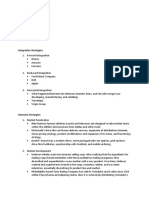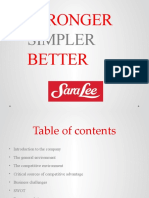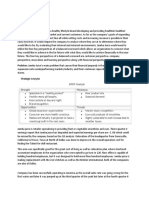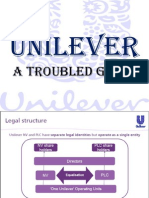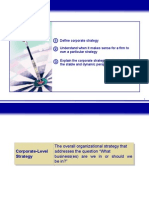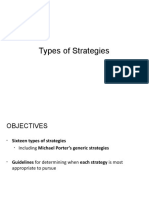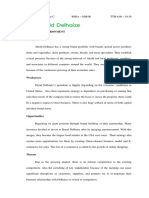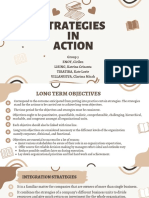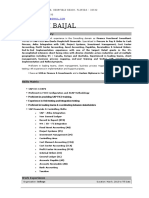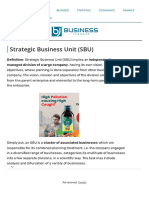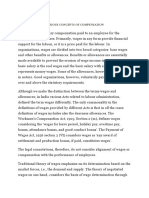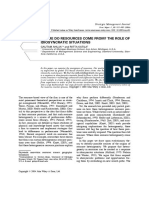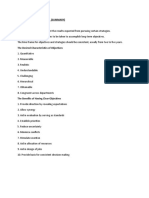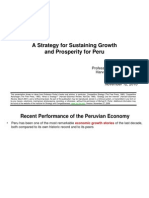Maggie Jones MGT 590
Module 5 Page 1
Sara Lee Corporation in 2011: Has Its Retrenchment Strategy Been Successful?
Executive Summary Sara Lee Corporation was founded in 1939 and, as of 2001, had acquired more than forty companies. Sales reached $10 billion in 1988, $15 billion in 1994, and $20 billion in 1998.However, revenues peaked in 1998, as Sara Lee struggled to manage the companys broadly diversified and geographically scattered operations. In February 2005, Brenda Barnes, Sara Lees newly appointed president and CEO, announced a strategic plan to transform Sara Lee into a more tightly focused food, beverage, and household products company. The centerpiece of Barness transformation plan was the divestiture of weak-performing business units and product categories accounting for $8.2 billion in sales - 40% of Sara Lees annual revenue. Barnes believed that Sara Lee could benefit from concentrating its financial and managerial resources on a smaller number of business segments where market prospects were promising and Sara Lees brands were well positioned. As the first phase of Barness transformation plan, Sara Lee was to exit eight businesses: Direct selling, U.S. retail coffee, European apparel, European nuts and snacks, European rice, U.S. meat snacks, European meats, and Sara Lee branded apparel.The latter was spun off as an independent company, Hanesbrands Inc. Following the disposition of these nonstrategic businesses in 2006, Sara Lee focused on increasing the sales, market shares, and profitability of its remaining businesses including North American Retail, North American Fresh Bakery, North American Foodservice, International Beverage, International Bakery, and International Household & Body Care.
�Maggie Jones MGT 590
Module 5 Page 2
Sara Lees management estimated that by focusing more on the stronger brands with good growth potential, its revenues would grow to $14 billion in fiscal 2010 and that the companys operating income margin would increase to at least 12%. Additionally, executives believed that the retrenchment strategy would generate sufficient cash flows to pay the companys total debt down to between $1.5 and $2 billion by fiscal 2010, pay substantial dividends to shareholders, and repurchase shares of common stock. Sara Lee missed both revenue and operating profit margin projections for 2010 and it was unclear whether the retrenchment strategy had increased shareholder value.During 2010, Sara Lee had engaged in further retrenchment with the divestiture of its International Household and Body Care business that produced and marketed Kiwi shoe care products, Sanex personal care products, AmbiPur air fresheners, and various insecticides and cleaning products sold outside North America.The same year, management launched a share buyback plan and Project Accelerate, a company-wide cost savings and productivity initiative focused on outsourcing, supply chain efficiencies, and overhead reduction, had saved the company $180 million.Barnes suffered a stroke and was succeeded by CFO Marcel Smits as interim CEO.i
Analysis Sara Lees retrenchment is based on a strategy of related diversification.As noted in our text, Related diversitication is based on value chain matchups with respect to key value chain activities.iiWith the exception of International Household & Body Care, which was slated for divesture in 2009, the businesses retained were all in the food and beverage industry and, given this relationship, relied on the same value chain activities such as production, purchasing, advertising, marketing, R&D,distribution, and customer service.This strategy provided Sara Lee
�Maggie Jones MGT 590
Module 5 Page 3
the opportunity to focus on food and beverages as a core competency while taking advantages of synergies between the different businesses.By facilitating the sharing or transferring of competitively important resources and capabilities, related diversification promised to boost each businesss prospects for competitive success.The retrenchment strategy allowed Sara Lee to take advantage of several cost sharing, skill transfer, and joint promotion opportunities between business units.
Evaluation While Sara Lees performance has been underwhelming since the retrenchment initiative was launched in 2005, the investment and divesture decisions were advised.Many of the businesses that were selected for divestment were unrelated to the companys core competencies.That is, their resource requirements and key value chain activities were so dissimilar that no competitively important cross-business relationships existed.iiiThese include direct selling, European apparel, and Sara Lee branded apparel. Divested businesses in the food and beverage industry such as European Nuts and Snacks, European Rice, and U.S. Meat Snacks were, for the most part, poor performers with low sales volume. The benefits of the companys decision to discontinue European meats, however, are less evident. The $1.1 billion dollar business seemed to have a good strategic fit with the other core businesses which were retained. Overall, the food and beverage industries in which Sara Lee competes are only moderately attractive. Nevertheless, the businesses which were targeted for investment have strong positions in their respective industries. While Sara Lee may not have fully realized the projected benefits of the retrenchment strategy, it continues to hold potential for the future.
�Maggie Jones MGT 590 Recommendations
Module 5 Page 4
In order to achieve the best results from their retrenchment strategy, its recommended that Sara Lee continue to focus on those businesses that offer the best growth opportunities, divest themselves of poorly performing businesses, and consider acquisition of companies that can contribute to Sara Lees future growth. Businesses that should be considered investment priorities in the coming years are those that offer the best opportunity to increase revenue.The best candidates include Sara Lee Foodservice and Sara Lee International Beverages.Simultaneously, the following businesses are recommended for divesture are International Household & Body Care and Sara Lee International Bakery. Finally, Sara Lee could benefit from the acquisition of up-and-coming companies or mergers with established firms in the other food and beverage industriesthat can help them quickly enter new markets or more rapidly expand in existing markets.Its recommended that the company continually monitor new entrants to the market in order to identify acquisition candidates.Similarly, it may be worthwhile to initiate discussions with larger food and beverage firms to identify whether a strategic alliance or merger can benefit both companies.
Thompson, Arthur A and Gamble, John E. Sara Lee Corporation in 2011: Has Its Retrenchment Strategy Been Sucessful? (2010). Crafting and Executing Strategy: The Quest for Competitive Advantage . New York, NY. McGraw Hill Irwin.
iiThompson,
Arthur A., Peteraf, Margareat A, Gamble, John E., and Strickland, A.J. ?(2010). Crafting and
Executing Strategy: The Quest for Competitive Advantage. New York, NY. McGraw Hill Irwin.p. 255.
iiiIbid.
p. 254.










